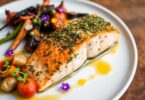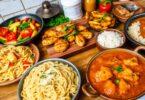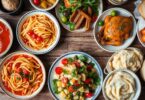Did you know that 60% of Americans prefer homemade meals over dining out? Cooking at home has become a popular trend. People seek to maintain control over the ingredients and nutritional value of their food. Whether you’re a seasoned home chef or a novice in the kitchen, this comprehensive guide will empower you. It will help you create delicious cooked food and elevate your culinary skills.
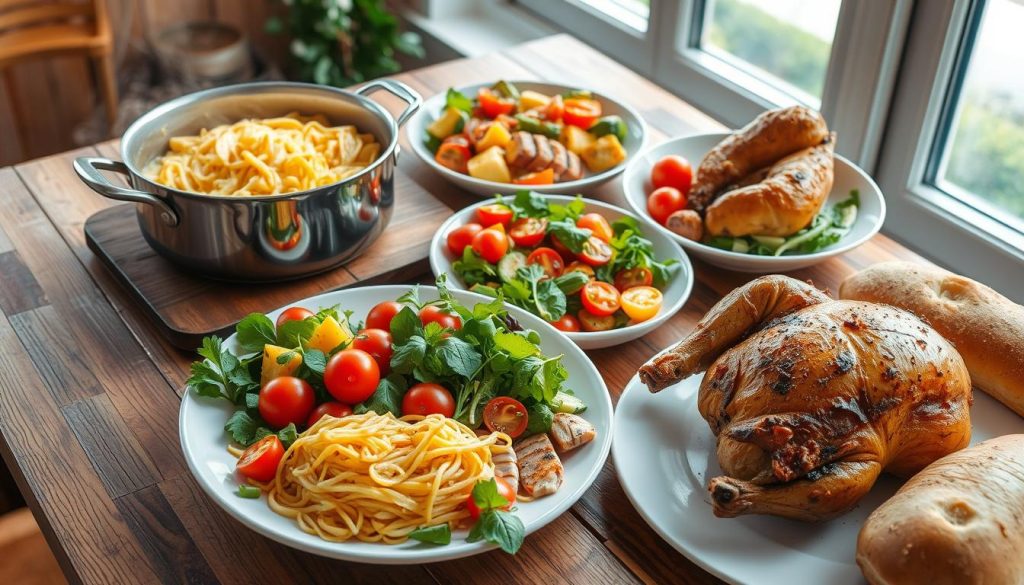
In this article, we’ll explore the essential tools, ingredients, and techniques needed to master the art of home cooking. From meal planning and preparation to understanding food safety and global cuisine, you’ll gain the confidence and knowledge. You’ll learn to transform your kitchen into a hub of delicious, homemade creations.
Key Takeaways
- Discover the must-have kitchen tools and equipment for home cooking
- Learn to stock your pantry with the essential ingredients for a well-rounded culinary repertoire
- Understand the fundamental cooking techniques that will elevate your home-cooked meals
- Explore budget-friendly cooking tips and tricks to maximize your culinary experience
- Dive into the world of international cuisine and learn to recreate global flavors at home
Getting Started with Home Cooking Essentials
Embarking on the journey of home cooking is both exciting and rewarding. It starts with the right kitchen essentials. You’ll need tools, equipment, and pantry items. A well-stocked kitchen unlocks your culinary arts potential.
Must-Have Kitchen Tools and Equipment
Proper tools are crucial for food preparation. Here are the essentials for any kitchen:
- A sharp chef’s knife for chopping, slicing, and dicing
- A sturdy cutting board for stable knife work
- Measuring cups and spoons for precise ingredient measurements
- Reliable pots and pans for various cooking methods
- A blender or food processor for sauces and mixes
- A timer to avoid overcooking
Basic Ingredients for Your Pantry
Stock your pantry with cooking tips and essential ingredients. Key items include:
- Olive oil and other oils for sautéing and frying
- Spices, herbs, and seasonings for flavor
- Canned goods for quick meal prep
- Grains like rice, pasta, and quinoa for filling meals
- Fresh or dried herbs to enhance taste
Understanding Kitchen Safety
A safe, organized kitchen is vital for cooking tips and food preparation. Key safety tips include:
| Safety Tip | Importance |
|---|---|
| Keep knives sharp and stored safely | Sharp knives are safer and easier to control than dull ones |
| Avoid clutter and clear workspace | A clean, organized kitchen reduces the risk of accidents |
| Wear appropriate clothing and footwear | Loose clothing and open-toed shoes can be hazardous near hot surfaces |
| Practice proper food handling and storage | Ensuring food safety helps prevent foodborne illnesses |
With the right kitchen essentials and safety knowledge, you’ll become a confident home cook.
The Art of Meal Planning and Preparation
Mastering meal planning and preparation is crucial for streamlining your cooking and saving time. By organizing your weekly menus, grocery shopping, and meal prep, you can simplify your daily cooking. This approach leads to more delicious, home-cooked meals.
Creating a weekly menu is a key step in effective meal planning. Start by reviewing your schedule for the upcoming week. Identify nights when you have more time to cook and those when you need quick meals. Balance your menu to ensure a varied and nutritious diet.
- Incorporate a mix of meal prep ideas, time-saving recipes, and simple-to-assemble dishes into your weekly menu.
- Plan meals that can be easily meal prepped in advance, such as soups, casseroles, or marinades.
- Identify opportunities to meal plan and prep on the weekends to streamline your weeknight cooking.
After setting your menu, create a detailed grocery list. Organize your list by category to make shopping more efficient. Consider buying in bulk for commonly used meal planning and meal prep staples.
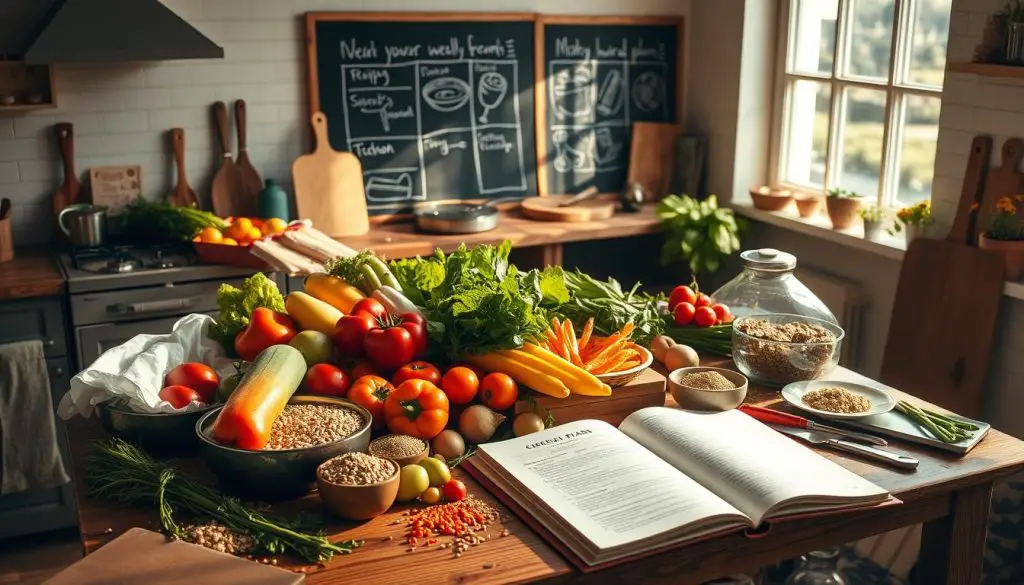
Finally, prep as much as possible in advance. Chop vegetables, portion out proteins, and assemble meals or components that can be easily reheated or assembled later. This food prep approach can significantly reduce daily cooking time and effort. It allows you to enjoy more home-cooked meals with less stress.
Fundamental Cooking Techniques Every Home Chef Should Know
To become a confident home cook, mastering key cooking techniques is essential. These skills are vital, whether you’re just starting or have years of experience. They lay the groundwork for your culinary journey, opening doors to a world of tasty dishes.
Mastering Heat Control
Effective heat management is crucial for successful cooking. Learn to adjust temperatures for searing, simmering, and sautéing. Experiment with different burner settings, oven temperatures, and cooking times. This will help you achieve the perfect texture and doneness in your dishes.
Knife Skills and Cutting Techniques
Using a knife with precision and confidence is transformative in the kitchen. Learn basic cuts like dicing, slicing, and julienning. Developing a proper knife grip and technique will speed up food preparation and enhance your dishes’ visual appeal.
Understanding Cooking Methods
Each cooking method, from sautéing and roasting to braising and poaching, offers unique benefits. Explore and master these techniques to cook a wide variety of dishes. This flexibility will make cooking easier and more enjoyable.
| Cooking Technique | Description | Best for |
|---|---|---|
| Sautéing | Quick-cooking over high heat in a small amount of fat | Vegetables, proteins, and small pieces of food |
| Roasting | Dry heat cooking in the oven, typically at high temperatures | Meats, poultry, and vegetables |
| Braising | Slow cooking in a small amount of liquid, often in the oven | Tougher cuts of meat and root vegetables |
| Poaching | Gently simmering food in a flavorful liquid | Delicate ingredients like eggs, fish, and fruit |
By mastering these fundamental cooking techniques, culinary skills, and understanding beginner cooking and food preparation, you’ll be able to create a wide variety of delicious meals at home.
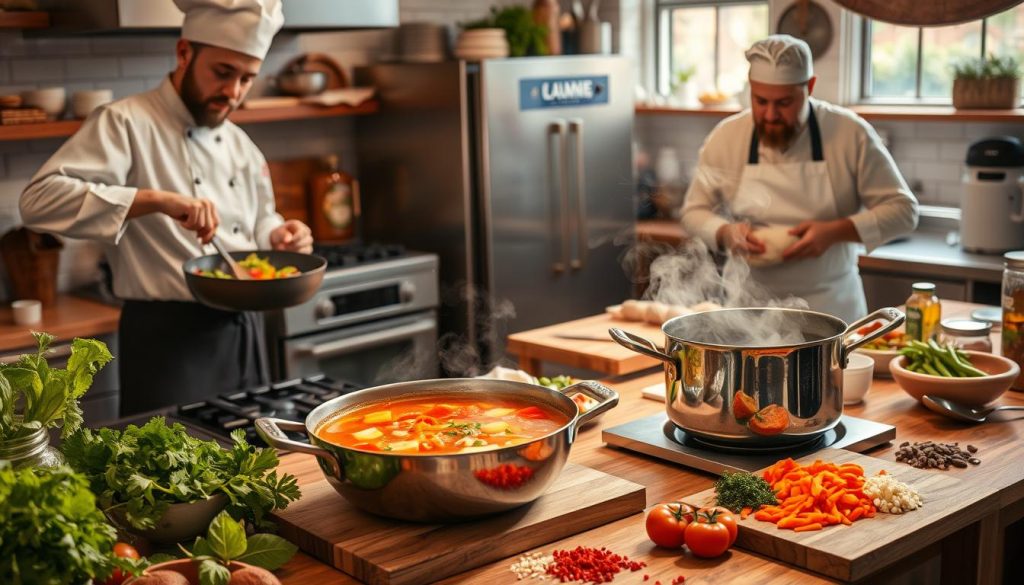
Understanding Cooked Food Safety and Storage
Ensuring food safety and proper storage is vital for enjoying home-cooked meals. By following key guidelines, your kitchen stays safe and clean. This also helps keep your meals fresh and of high quality.
First, it’s crucial to follow basic food safety rules. This means cooking meals to the right internal temperatures and refrigerating or freezing leftovers quickly. It’s also important to keep your kitchen clean and sanitized. Good meal prep habits and kitchen safety practices, like avoiding cross-contamination, are essential.
Storing Cooked Meals Safely
Proper storage is critical for the quality and safety of prepared meals. Cooked dishes should be refrigerated or frozen immediately. Use airtight containers or resealable bags for storage. The fridge should be at 40°F (4°C) or below, and the freezer at 0°F (-18°C) or lower.
| Storage Guideline | Refrigerator (40°F or below) | Freezer (0°F or below) |
|---|---|---|
| Cooked Dishes | 3-4 days | 2-3 months |
| Cooked Meat or Poultry | 3-4 days | 2-6 months |
| Cooked Fish | 3-4 days | 2-3 months |
By adhering to these guidelines and keeping your kitchen clean, you can enjoy the benefits of home-cooked meals. This approach ensures food safety and reduces waste.

“Proper food storage and handling are essential for maintaining the quality and safety of your cooked meals.”
Quick and Easy Weeknight Dinner Ideas
Busy weeknights demand swift, tasty, and effortless dinner options. This section offers a range of quick dinner ideas and easy recipes. They’re designed to streamline your weeknight cooking, whether you’re after a 30-minute meal, a one-pot dish, or something to prepare ahead.
30-Minute Meal Solutions
For those in a rush, these 30-minute meal solutions ensure a homemade dinner swiftly. Discover a variety of quick dinner ideas that are simple to make yet bursting with flavor. Options include stir-fries, pasta dishes, sheet pan meals, and skillet recipes.
One-Pot Wonder Recipes
One-pot meals are perfect for reducing cleanup. These easy recipes combine all ingredients in one vessel, simplifying the cooking process. Enjoy a range of one-pot wonder recipes, from comforting soups and stews to hearty casseroles and risottos.
Make-Ahead Meal Options
Advance planning can significantly ease weekday stress. Make-ahead meal options enable you to prep parts or entire dishes beforehand. This ensures a delicious, hassle-free dinner with just a quick reheat. Explore various meal ideas for assembly ahead of time, including freezer-friendly casseroles, grab-and-go salads, and bowls.
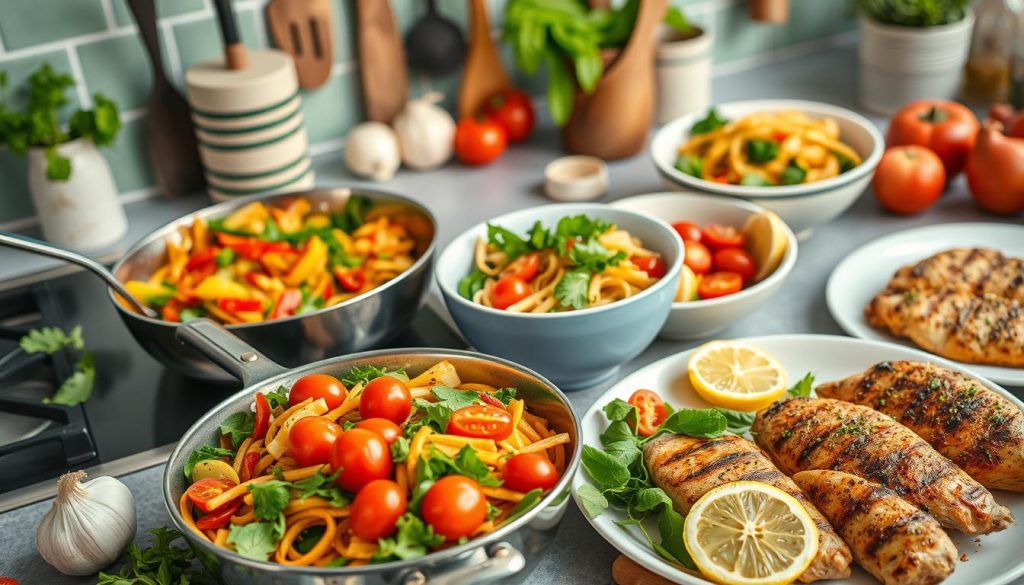
“The key to successful weeknight cooking is having a plan and using time-saving techniques. With the right quick dinner ideas and easy recipes in your arsenal, you can enjoy a homemade meal without the hassle.”
Mastering the Art of Seasoning and Spices
In the culinary world, mastering spices and seasonings can elevate a dish from good to great. Whether you’re making flavorful dishes or sauces, seasoning is crucial. Let’s delve into the world of spice combinations and discover how to enhance your cooking.
The Power of Spice Blends
Spice combinations are key to unlocking flavors in your dishes. From cumin and coriander’s earthy notes to garam masala’s bold aroma, understanding spice blends is essential. Experiment with various combinations to find the perfect flavor that excites your taste buds.
Mastering Homemade Sauce Recipes
Take your cooking to the next level by mastering homemade sauces. From vibrant pesto to creamy béchamel, homemade sauces add depth to dishes. Explore how spices and herbs can transform your sauces, making each dish unique.
Balancing Flavors: The Key to Deliciousness
Perfecting flavor balance is crucial for a home chef. Learn to mix sweet, sour, salty, and umami elements in your dishes. By adding spices and seasonings, you can create meals that are both satisfying and memorable.
| Spice Combination | Recommended Dishes |
|---|---|
| Garam Masala | Curries, lentil dishes, roasted vegetables |
| Cajun Seasoning | Blackened fish, grilled chicken, Jambalaya |
| Italian Herbs | Pasta sauces, pizza, bruschetta |
Embrace the art of seasoning and spices to unlock delicious possibilities in your kitchen. With experimentation and a deep understanding of flavors, you’ll create dishes that impress everyone.
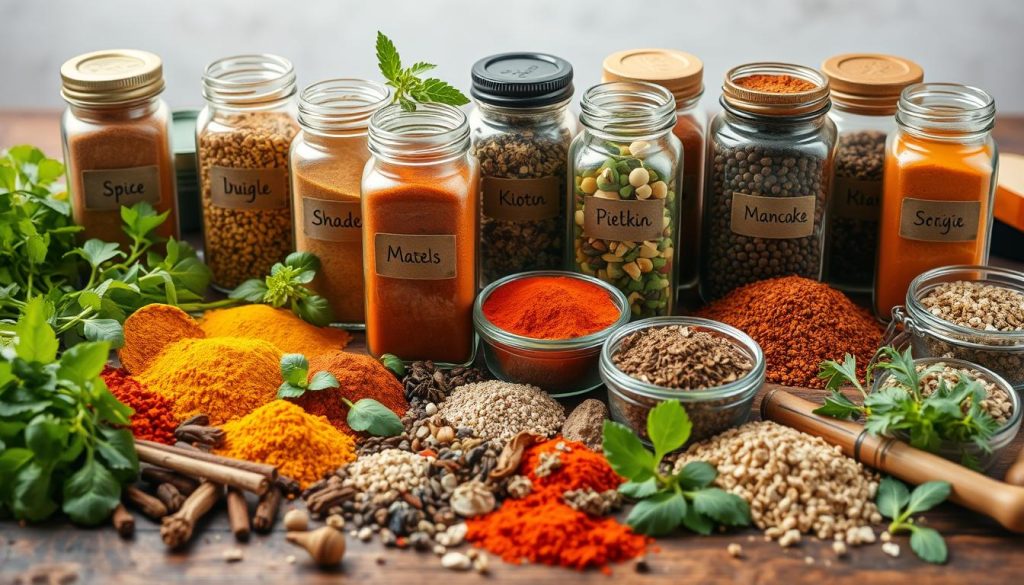
“The secret of good cooking is, first, having a love of it… If you’re afraid of the food, you’ll never be a good cook.”
– Julia Child
International Cuisine Made Simple
Start a culinary journey around the world with simplified international recipes. Discover the rich diversity of global cuisines and learn to recreate authentic flavors in your kitchen. This section introduces essential international ingredients, popular dishes from various cultures, and traditional cooking methods. These will help you expand your culinary horizons.
Essential Global Ingredients
Unlock the secrets of international cuisine by familiarizing yourself with essential global ingredients. From aromatic spices and flavorful herbs to versatile staples, these pantry essentials will become the foundation for your global culinary adventures. Explore the unique flavors of ingredients like:
- Cumin, coriander, and turmeric from the Middle East
- Lemongrass, fish sauce, and coconut milk from Southeast Asia
- Chili peppers, cilantro, and lime from Latin America
- Ginger, soy sauce, and mirin from East Asia
Popular World Recipes
Discover the diverse range of delicious dishes from around the globe. From the comforting curries of India to the vibrant street food of Mexico, international cuisine offers a wealth of culinary delights waiting to be explored. Familiarize yourself with classics like:
- Pad Thai from Thailand
- Ramen from Japan
- Paella from Spain
- Falafel from the Middle East
- Tacos al pastor from Mexico
Authentic Cooking Methods
Delve into the traditional cooking techniques that give international dishes their unique flavors and textures. From the slow-simmered stews of Europe to the high-heat wok-frying of Asia, understanding authentic cooking methods will help you recreate the authentic tastes of the world in your own kitchen. Explore techniques like:
| Cooking Method | Description | Cuisine Origin |
|---|---|---|
| Braising | Slow-cooking meat or vegetables in liquid | Europe |
| Tandoor | High-heat clay oven cooking | South Asia |
| Stir-frying | Quick-cooking over high heat in a wok | East Asia |
By mastering these essential global ingredients, popular world recipes, and authentic cooking methods, you’ll be well on your way to creating delicious international cuisine in your own kitchen.
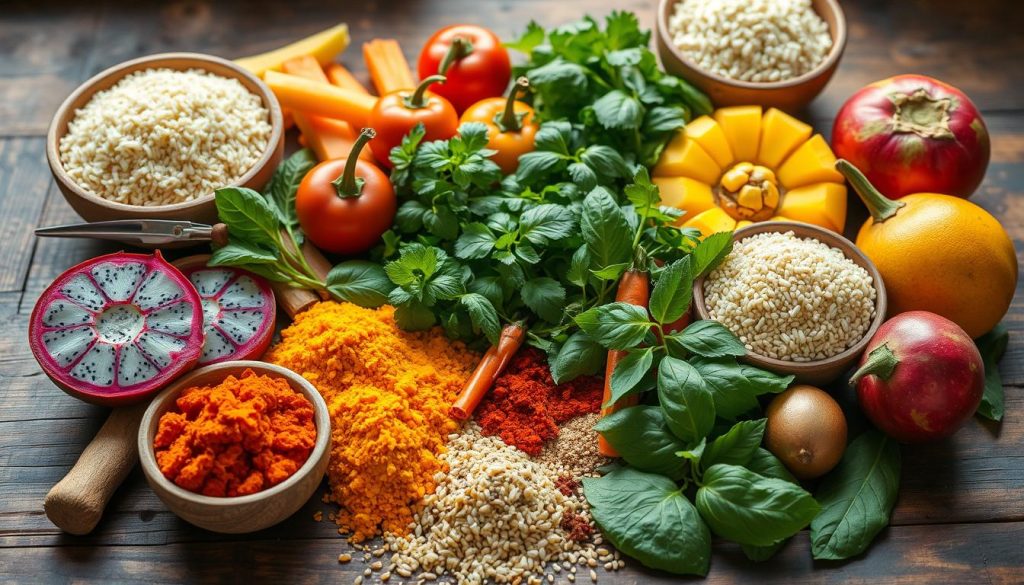
“The world is a book, and those who do not travel read only a page.” – Saint Augustine
Healthy Cooking Methods and Nutritious Meals
Understanding healthy cooking techniques is key to enjoying flavorful home-cooked meals. This section will delve into various nutritious cooking methods and tasty meal ideas. These will align with your wellness goals without sacrificing taste.
Embracing Plant-Based Cooking
Plant-based diets are increasingly popular for their health benefits and environmental impact. Adding more plant-based ingredients to your meals can significantly boost your nutrient intake. Discover the versatility of whole grains, legumes, and fresh produce to craft low-calorie, nutrient-rich dishes.
Low-Calorie Cooking Techniques
- Steaming: This method preserves natural flavors and nutrients, eliminating the need for added fats or oils.
- Roasting: It enhances the natural sweetness of vegetables, keeping them crisp and flavorful, making it a great low-calorie choice.
- Grilling: It adds a smoky, caramelized flavor to meals, allowing you to enjoy healthy proteins and produce without extra calories.
Nutritious Meal Ideas
Creating nourishing, delicious meals is essential for sustainable healthy eating. From hearty grain bowls to vibrant veggie-packed stir-fries, the options are vast. Try various nutrient-dense ingredients to craft balanced, low-calorie meals that energize and satisfy.
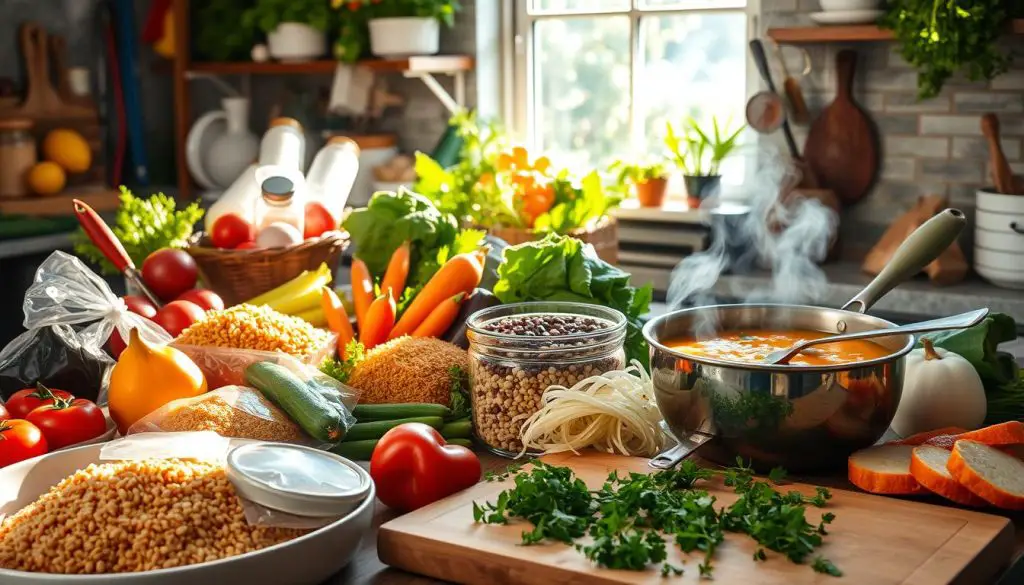
“Healthy cooking is not about deprivation, it’s about abundance – abundance of flavor, color, texture, and nourishment.”
By adopting healthy cooking methods and focusing on nutritious ingredients, you can enjoy the benefits of home-cooked meals. These meals support your overall well-being. Discover the joy of making healthy, satisfying dishes that nourish both your body and taste buds.
Budget-Friendly Cooking Tips and Tricks
Cooking delicious meals at home doesn’t have to be expensive. With a few smart strategies, you can enjoy tasty dishes while keeping your budget in check. Let’s explore some budget-friendly cooking tips and tricks to help you make the most of your grocery budget.
Smart Shopping Strategies
When it comes to budget-friendly cooking, smart shopping is crucial. Begin by making a plan and sticking to a grocery list. Look for sales, use coupons, and choose seasonal produce to get the best deals. Buying in bulk for non-perishable items can also save you money.
Utilizing Leftovers Creatively
Repurposing leftovers is a great way to stretch your food budget. Get creative with recipe substitutions and turn last night’s meal into a new dish. Soups, casseroles, and fried rice are excellent options for using up leftovers in a delicious way.
Seasonal Cooking Guide
Embracing seasonal recipes is a surefire way to enjoy fresh, flavorful ingredients at their peak while saving money. Familiarize yourself with the seasonal food trends in your area and plan your meals accordingly. This not only ensures you’re getting the best value but also enhances the taste of your dishes.
By implementing these budget-friendly cooking strategies, you can enjoy a variety of delectable meals without breaking the bank. Bon appétit!
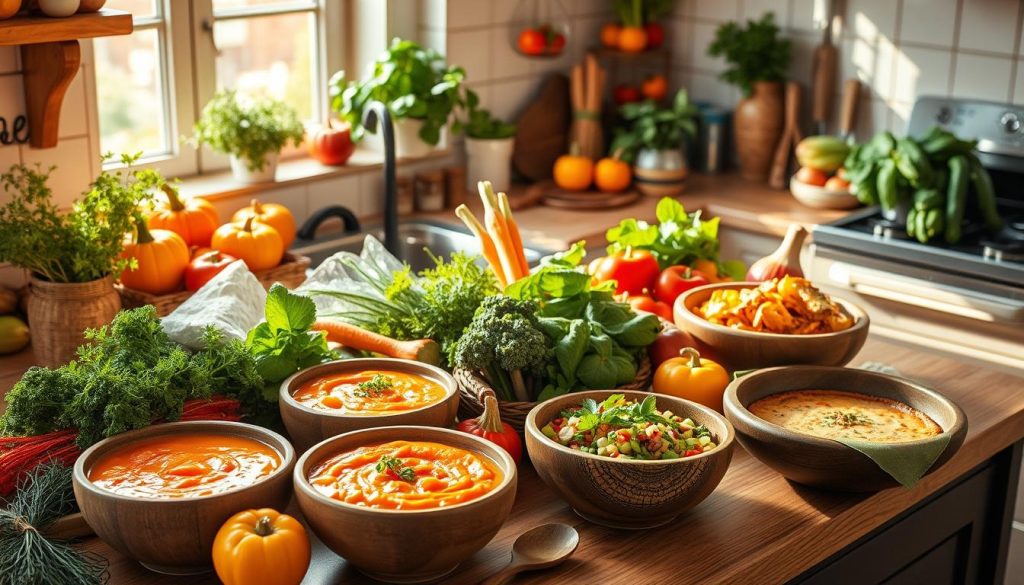
Baking Basics for Beginners
Baking offers a world of joy and accomplishment, especially for newcomers. Whether you aim to make comforting homemade meals or festive holiday recipes, understanding baking basics is crucial. This section will cover essential baking tips and techniques to guide you through the world of homemade baked goods.
Gather the Right Ingredients
Starting with the right ingredients is key to successful baking. Ensure your pantry is stocked with staples like all-purpose flour, sugar, baking powder, baking soda, and salt. Also, keep comfort food essentials like butter, eggs, and milk on hand. Accurate measuring is vital, so have reliable measuring cups and spoons ready.
Master Basic Mixing Techniques
- Learn the difference between creaming, folding, and whisking techniques to achieve the perfect texture in your baked goods.
- Understand the importance of properly preparing your baking pans, whether it’s greasing, lining, or dusting them with flour.
- Familiarize yourself with the various mixing methods, such as the muffin method, the two-bowl method, and the one-bowl method, to suit different recipes.
Develop an Eye for Doneness
Knowing when your baked goods are perfectly cooked is a vital skill. Look for visual cues like a golden-brown crust or a firm center. Use a toothpick or skewer to check for clean insertion, indicating the baked item is ready to be removed from the oven.
With these baking tips, you’ll be well on your way to creating delicious, homemade baked goods. These will surely delight your family and friends. Embrace the art of baking and let your creativity shine in every warm, freshly-baked creation.
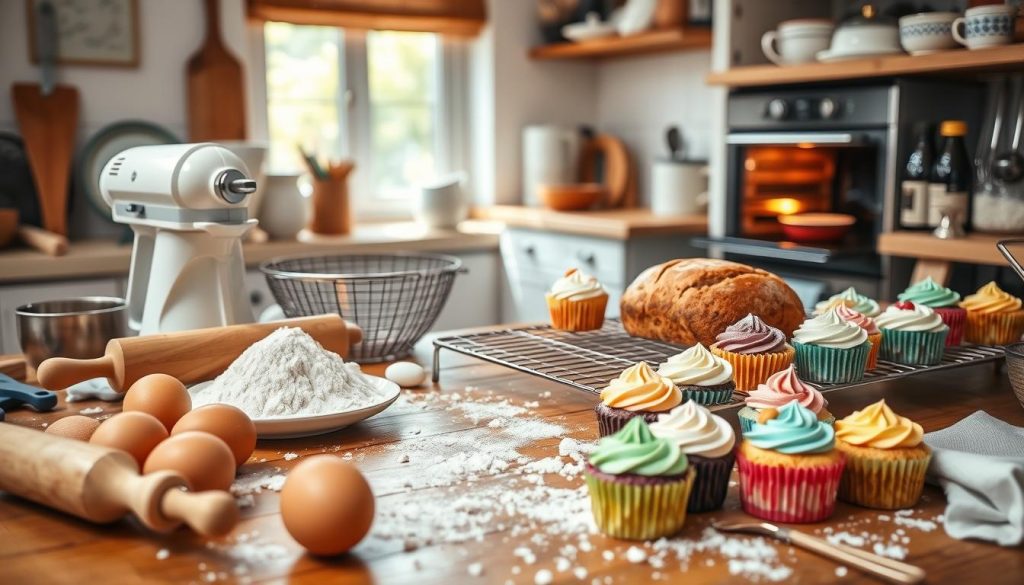
Time-Saving Kitchen Hacks and Shortcuts
In today’s fast-paced world, every second in the kitchen matters. Luckily, there are many shortcuts and tricks to make cooking quicker and more efficient. This section will share practical tips for better meal prep and kitchen organization. These strategies will help you cook with confidence and save time.
Prep Work Strategies
Effective meal prep begins with smart prep work. Here are some time-saving tips:
- Batch-chop vegetables in advance and keep them in the fridge for quick use.
- Marinate proteins overnight to save time and add flavor.
- Pre-measure spices and seasonings to speed up cooking.
Kitchen Organization Tips
Organizing your kitchen can make cooking more efficient. Try these tips to improve your workspace:
- Use space-saving storage like drawer dividers and stackable containers to reduce clutter.
- Organize similar items together for easier access.
- Label and date pantry items to avoid expired food.
Efficient Cooking Methods
There are many ways to cook more efficiently. Here are some methods to consider:
| Cooking Method | Time-Saving Benefit |
|---|---|
| One-pot meals | Less cleanup since you cook everything in one pot. |
| Slow cooker or Instant Pot | Hands-off cooking for tender, flavorful dishes. |
| Meal prepping | Cook large batches for quick meals all week. |
By using these cooking hacks, kitchen gadgets, and efficient cooking methods, you can make meal prep faster. Enjoy more time with family and friends. These shortcuts will simplify your cooking routine.
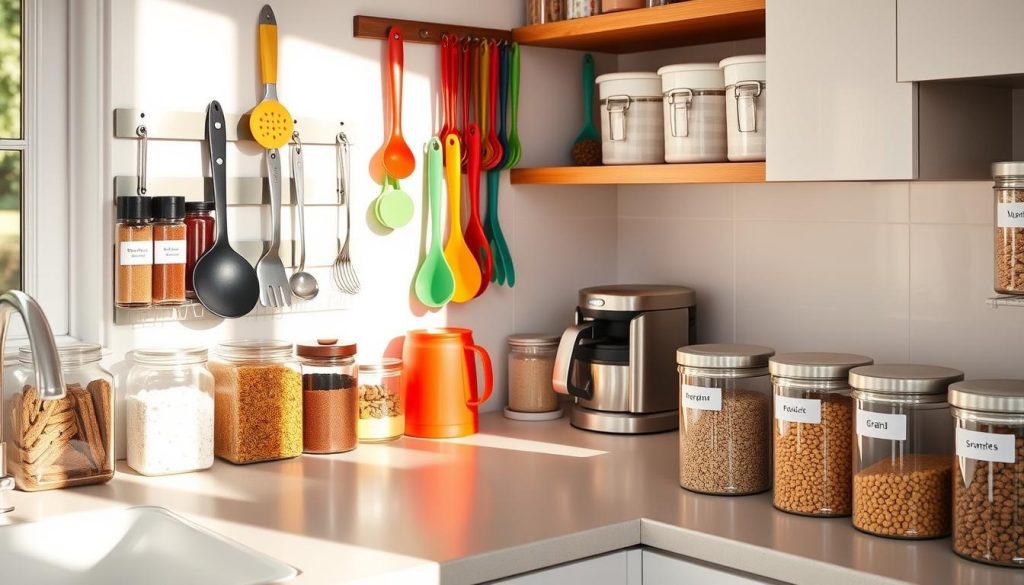
Special Dietary Considerations and Alternatives
Cooking for diverse dietary needs and preferences is a rewarding challenge. Whether you’re exploring vegetarian recipes, seeking dairy-free options, or catering to gluten-free requirements, this section offers insights and strategies. Discover alternative ingredients, recipe adaptations, and cooking techniques to create delicious, nutritious meals. These meals cater to various food trends and lifestyle choices.
For those seeking meatless options, our collection of flavorful vegetarian recipes showcases the versatility of plant-based ingredients. From hearty lentil stews to creative vegetable-forward dishes, you’ll find a wealth of inspiring ideas. These ideas satisfy even the most discerning palates. Similarly, our dairy-free recipes provide creamy, indulgent alternatives using nut-based milks, plant-based cheeses, and innovative substitutions.
Gluten-free cooking has become increasingly popular, and this section equips you with the knowledge to prepare satisfying meals without compromising on taste or texture. Explore the use of gluten-free flours, grains, and thickening agents to recreate your favorite dishes. This ensures that everyone at the table can enjoy a fulfilling dining experience.
FAQ
What are some essential kitchen tools and equipment I should have for home cooking?
Essential kitchen tools include a good set of knives and a sturdy cutting board. You’ll also need various pots and pans, measuring cups and spoons, and a blender or food processor. Basic cooking utensils like spatulas, whisks, and tongs are also crucial. Having the right tools can significantly enhance your cooking experience.
How do I plan and prep my meals efficiently?
To plan meals efficiently, start by creating a weekly menu and a detailed grocery list. Prepping ingredients and components in advance is key. This can involve chopping vegetables, marinating proteins, or assembling meals for later reheating. Investing time upfront can greatly reduce stress during busy weekdays.
What are some essential cooking techniques I should master?
Mastering basic cooking techniques is vital. This includes controlling heat, knife skills, and understanding methods like sautéing, roasting, and braising. Developing these skills will empower you to tackle a wide range of recipes confidently.
How can I ensure the safety and storage of my cooked food?
Ensuring food safety is paramount. This involves cooking foods to the right temperature, storing them correctly, and maintaining good hygiene. Learn about food storage guidelines and how to safely handle and reheat leftovers to prevent illness.
What are some quick and easy weeknight dinner ideas?
For quick weeknights, focus on 30-minute meals and one-pot wonders. Make-ahead options that reheat well are also great. Try stir-fries, sheet pan dinners, pasta bakes, and slow cooker recipes. These dishes are quick to prepare and nutritious.
How can I enhance the flavors of my dishes through seasoning and spices?
Enhancing flavors is all about seasoning. Experiment with spice blends, homemade sauces, and techniques like marinating and brining. Balance sweet, sour, salty, and umami flavors for a well-rounded taste in your dishes.
How can I incorporate more healthy and nutritious meals into my cooking routine?
To add more nutrition, try roasting, steaming, and grilling. These methods preserve nutrients. Include more plant-based proteins, whole grains, and fresh produce in your meals. Experiment with substitutions and new recipes that are both healthy and flavorful.
What are some budget-friendly cooking tips and tricks?
To save money, shop smart by buying in bulk and using seasonal produce. Utilize leftovers creatively. Learn to make the most of your budget with meal planning and recipe substitutions.
What are the basic baking techniques I should know as a beginner?
Start with baking basics like accurate measuring, understanding leavening agents, and mastering mixing techniques. Familiarize yourself with common baking equipment and learn to troubleshoot common issues. Begin with simple recipes to build your confidence.
What are some time-saving kitchen hacks and shortcuts I can use?
Use batch prepping, organize your kitchen, and explore time-saving methods like the Instant Pot or air fryer. Practical kitchen hacks can streamline your cooking, saving time and effort.
How can I accommodate special dietary needs and preferences in my cooking?
Catering to diets like vegetarian, dairy-free, or gluten-free is achievable. Learn about alternative ingredients and cooking techniques. This way, you can make your cooking inclusive and accessible to various dietary needs.


